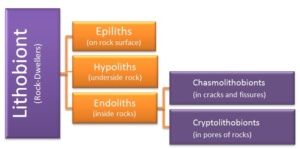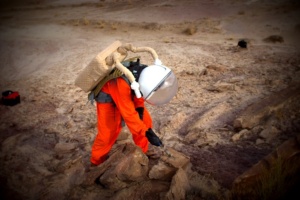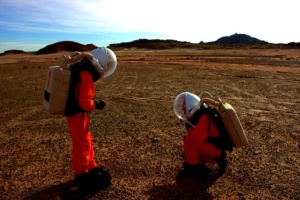Science Report – October 27th
Lithobionts and Science Goals of the MARS 160 Mission
By Crew Biologist Anushree Srivastava
It is sol 28 and a sol of a very productive extra-vehicular activity (EVA). Today, we started off our EVA towards the east of MDRS habitat having these objectives in mind – investigation of hypolithic abundance and exploration of some exotic lithobionts or rock dwellers. Fundamentally, lithobionts or rock-dwelling organisms can be described and segregated into three categories – epiliths, hypoliths, and endoliths – according to their interaction with the substrate. Epiliths, as the name suggests, colonize on the surface of the rocks, usually igneous rock surfaces. Hypoliths are microbial communities that grow ventral or undersides of translucent rocks such as quartz, granite, limestone, and gypsum. Endoliths populate and adapt to different ecological niches of the interior of the rocks. They can further be segmented into chasmolithobionts, which lies in between or in interstitial space of crevices and cracks, and cryptolithobionts, which reside in the porous regions of the rocks, principally sandstone. As part of MARS 160 astrobiological research, both in MDRS in the Utah Desert and FMARS in the Arctic, we intend to study the hypolith abundance for each experimental site. To move beyond that we will explore some rare lithobionts for molecular analysis using the MinION – an essential device for DNA sequencing. Documenting hypolith abundance in the Martian analog site of MDRS will inform us about the extent of ecological adaptations of these rock-dwellers in this extreme environment. Additionally, the DNA analysis of rare lithobionts will help us in specie identification and equip us with advanced understanding of the differences in the nature of these organisms as lithobionts have not been extensively studied from the molecular point of view. So our study will provide a profound baseline in this domain and help us anticipate “exophiles” on Mars.

Classification of Lithobionts. Image Credit: Makhalanyane, Pointing and Cowan, 2014.

In search for rare lithobionts.

Conducting hypolith abundance study.
Further Reading
Makhalanyane TP, Pointing SB, Cowan DA (2014) Lithobionts: Cryptic and Refuge Niches. Antarctic Terrestrial Microbiology, pp: 163-179
Warren-Rhodes KA, McKay CP, Boyle LN, Wing MR, Kiekebusch EM, Cowan DA, Stomeo F, Pointing SB, Kaseke KF, Eckardt F, Henschel JR, Anisfeld A, Seely M, Rhodes KL (2013) Physical ecology of hypolithic communities in the central Namib Desert: The role of fog, rain, rock habitat, and light. Journal of Geophysical Research: Biosciences 118: 1–10



